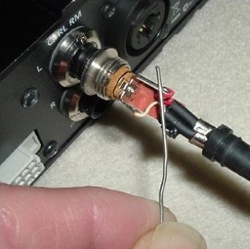
When connecting this type of output to an unbalanced input, grounding pin 3 by inserting an “unbalanced” TS plug into the balanced jack works just fine.
Manufacturers like this arrangement because they don’t have to explain everything that you’re reading here to novice users; they can simply write in the manual, “use an unbalanced cable to go to an unbalanced input,” and ensure predictable results.
This configuration is often called “impedance balanced” or “single-ended balanced,” although many manufacturers like to describe it as “balanced/unbalanced.” Needless to say, as the simplest and least expensive approach of the lot, it’s popular with manufacturers, particularly with gear most appropriate for personal-studio use.
PreSonus StudioLive mixers use this configuration on all of the balanced outputs on ¼-inch jacks, with exception of the Main ¼-inch jacks, which duplicate the Main XLR outputs. The DB25 connectors carrying the direct analog outputs are also wired in this manner.
Red Herrings
While unrelated to this balanced/unbalanced discussion, there are a couple of other two-circuit jacks commonly found on audio gear that are worth mentioning. As noted earlier, insert jacks, unless there’s a separate jack for the send and return, are unbalanced. One circuit (typically the tip) is an unbalanced, output and the other is an unbalanced input. Pay attention to these connection guidelines when connecting a processor with balanced inputs and/or outputs to channel inserts.
Stereo input and output jacks as commonly found on handheld recorders and players these days are just that – two unbalanced inputs or outputs. Headphone jacks are also unbalanced outputs, generally with a small power amplifier driving them to assure ear-splitting volume with nearly any type of earphone.
Identifying Your Output Configuration
How do you know what type of balanced output you have? The easiest way is to look at the schematic diagram. Published schematics are a rarity these days but you might get a clue from the product specs, literature, or a block diagram. If the output is transformer balanced, the manufacturer will probably brag about it. If it’s a ¼-inch jack, and the manual or spec sheet says “balanced/unbalanced,” it’s probably single-ended, balanced with a resistor.
You can confirm this by sending a signal to the output in question and plugging a set of headphones into the output jack (easiest, of course, if it’s a ¼-inch phone jack). If it’s a single-ended balanced output, you’ll hear sound only in one earphone. If you hear sound in both ears, the tip and ring both carry signal. A symmetrical balanced output will sound odd because the signals going to the two earphones are 180° out of phase with respect to each other.
It’s a little more complicated to determine whether an active balanced symmetrical output is cross-coupled or uses a single op-amp to get the inverted output. To sort this out, you’ll need to look at or listen to the level on pin 2 while temporarily shorting pin 3 to pin 1.
If your headphone plug has a removable cover, you can check this easily by shorting the ring terminal of the plug (the one closest to the cable end) to the sleeve. An unbent paper clip or a small screwdriver works well for this, or you can use a clip lead. If the level increases, you have a cross-coupled output stage. If it doesn’t change, decreases slightly, or distorts, you have a simple inverter in the output stage. For this test, just listen to the left earphone, since conventional headphone wiring is with the tip (pin 2) going to the left ear. Don’t worry about what you hear in the right earphone.
What’s Best?
Using balanced connections throughout your system is, of course, best. You won’t sacrifice operating level or headroom, and you’ll have the best immunity from outside noise sources like the TV station across the street or the GSM cell phone in your pocket. A balanced connection also offers more options for dealing with grounding and shielding if you have a hum problem, though that’s a topic for another day.
In practice, however, you’ll probably have a mixture of balanced and unbalanced gozoutas and gozintas to connect. With the proper understanding of what’s what, you can achieve good results.
Mike Rivers has an electronic engineering degree and over 35 years as a design, system, and government engineer, while also operating a part-time recording studio and remote-recording truck. He is retired, but he continues to take on occasional projects, such as writing for PreSonus Audio Electronics. The original article, along with plenty of additional links to reference material, can be read here.
